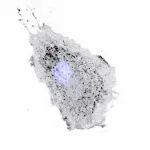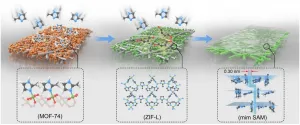(Press-News.org) WASHINGTON, July 21, 2021 -- As the Summer Olympics draw near, the world will shift its focus to photo finishes and races determined by mere fractions of a second. Obtaining such split-second measurements relies on faultlessly rounding a raw time recorded by a stopwatch or electronic timing system to a submitted time.
Researchers at the University of Surrey found certain stopwatches commit rounding errors when converting raw times to final submitted times. In American Journal of Physics, by AIP Publishing, David Faux and Janet Godolphin outline a series of computer simulations based on procedures for converting raw race times for display.
Faux was inspired when he encountered the issue firsthand while volunteering at a swim meet. While helping input times into the computer, he noticed a large portion of times they inputted were rounded to either the closest half-second or full second.
"Later, when the frequencies of the digit pairs were plotted, a distinct pattern emerged," he said. "We discovered that the distribution of digit pairs was statistically inconsistent with the hypothesis that each digit pair was equally likely, as one would expect from stopwatches."
Stopwatches and electronic timing systems use quartz oscillators to measure time intervals, with each oscillation calculated as 0.0001 seconds. These times are then processed for display to 0.01 seconds, for example, to the public at a sporting venue.
Faux and Godolphin set to work simulating roughly 3 million race times corresponding to swimmers of all ages and abilities. As expected, the raw times indicated each fraction of a second had the same chance of being a race time. For example, there was 1% chance a race time ended in either 0.55 seconds or 0.6 seconds.
When they processed raw times through the standard display routine, the uniform distribution disappeared. Most times were correctly displayed.
Where rounding errors occurred, they usually resulted in changes of one one-hundredth of a second. One raw time of 28.3194 was converted to a displayed time of 28.21.
"The question we really need to answer is whether rounding errors are uncorrected in electronic timing systems used in sporting events worldwide," Faux said. "We have so far been unable to unearth the actual algorithm that is used to translate a count of quartz oscillations to a display."
The researchers collected more than 30,000 race times from swimming competitions and will investigate if anomalous timing patterns appear in the collection, which would suggest the potential for rounding errors in major sporting events.
INFORMATION:
The article "The floating point: Rounding error in timing devices" is authored by David A. Faux and Janet Godolphin. The article appears in American Journal of Physics (DOI: 10.1119/10.0003919), and it can be accessed at https://doi.org/10.1119/10.0003919.
ABOUT THE JOURNAL
American Journal of Physics is devoted to the instructional and cultural aspects of physics. The journal informs physics education globally with member subscriptions, institutional subscriptions, such as libraries and physics departments, and consortia agreements. It is geared to an advanced audience, primarily at the college level. Contents include novel approaches to laboratory and classroom instruction, insightful articles on topics in classical and modern physics, apparatus, and demonstration notes, historical or cultural topics, resource letters, research in physics education, and book reviews. See https://aapt.scitation.org/journal/ajp.
About AAPT
AAPT is an international organization for physics educators, physicists, and industrial scientists--with members worldwide. Dedicated to enhancing the understanding and appreciation of physics through teaching, AAPT provides awards, publications, and programs that encourage teaching practical application of physics principles, support continuing professional development, and reward excellence in physics education. AAPT was founded in 1930 and is headquartered in the American Center for Physics in College Park, Maryland.
ITHACA, N.Y. - Cornell researchers have developed nanostructures that enable record-breaking conversion of laser pulses into high-harmonic generation, paving the way for new scientific tools for high-resolution imaging and studying physical processes that occur at the scale of an attosecond - one quintillionth of a second.
High-harmonic generation has long been used to merge photons from a pulsing laser into one, ultrashort photon with much higher energy, producing extreme ultraviolet light and X-rays used for a variety of scientific purposes. Traditionally, gases have been used as sources of harmonics, but a research team led by Gennady Shvets, professor of applied and engineering physics ...
Researchers at Weill Cornell Medicine and NewYork-Presbyterian in New York have discovered that injecting mice with pulmonary endothelial cells--the cells that line the walls of blood vessels in the lung--can reverse the symptoms of emphysema. The study, which will be published July 21 in the Journal of Experimental Medicine (JEM), may lead to new treatments for chronic obstructive pulmonary disease (COPD), an inflammatory lung disease associated with smoking that is thought to be the third leading cause of death worldwide.
Emphysema is one of the characteristic features ...
Wearable devices can detect people's stress, according to new Washington State University research, opening potential new interventions for people with addictions.
In a paper published today, July 21, in the END ...
A landmark scientific study involving marine biologists from Greece, Turkey, Cyprus, Libya, Italy, Tunisia, the UK, the US and even Malta, documenting instances where native Mediterranean species have preyed upon two highly invasive marine fish - the Pacific red lionfish and the silver-cheeked toadfish - has just been published. Prof. Alan Deidun, coordinator of the Spot the Alien Fish citizen science campaign and resident academic within the Department of Geosciences of the Faculty of Science, is a co-author of such an extensive study.
The Pacific red lionfish (Pterois miles) and the silver-cheeked toadfish (Lagocephalus sceleratus) are amongst the most invasive of non-indigenous fish species to enter the Mediterranean in recent years, posing both ecological and socio-economic hazards. ...
SARS-CoV-2 still poses major challenges to mankind. The frequent emergence of mutant forms makes the threat posed by the virus difficult to predict. The SARS-CoV-2 variant B.1.617 circulated in India and gave rise to the Delta variant, B.1.617.2, which is now becoming dominant in many countries. Infection researchers from the German Primate Center (DPZ) - Leibniz Institute for Primate Research in Göttingen have investigated the B.1.617 variant in detail. In cell culture studies, they found that this variant can infect certain lung and intestinal cell lines more efficiently than the original ...
A high proportion of staff working in intensive care units during the COVID-19 pandemic have experienced mental health conditions, according to a new study.
In a study of 515 healthcare staff working in intensive care units (ICUs) across seven countries, the researchers found that on average 48 percent of participants showed signs of mental health conditions - depression, insomnia and post-traumatic stress disorder (PTSD). Their mental health was assessed using a detailed questionnaire and a clinical scoring system.
The team also found a 40 per cent increase in the conditions for those who spent more than six hours in personal protective equipment (PPE) over ...
At low temperatures, certain materials lose their electrical resistance and conduct electricity without any loss - this phenomenon of superconductivity has been known since 1911, but it is still not fully understood. And that is a pity, because finding a material that would still have superconducting properties even at high temperatures would probably trigger a technological revolution.
A discovery made at TU Wien (Vienna) could be an important step in this direction: A team of solid-state physicists studied an unusual material - a so-called "strange metal" made of ytterbium, rhodium and silicon. Strange metals show an unusual relationship between electrical resistance and temperature. ...
A protein involved in making cells move offers a clue to how certain types of cancer metastasize and develop into secondary tumours, according to new research from the University of Warwick.
Scientists from Warwick Medical School have demonstrated for the first time that levels of this protein can increase and decrease the movement of a cell, including cancer cells - suggesting that they could play a role in the spread of tumours.
The study is published today (21 July) in the Journal of Cell Biology and was funded by the Medical Research Council, part of UK Research and Innovation.
The researchers are investigating a tiny cell component called an Intracellular nanovesicle (INV) which acts like a courier within a cell by transporting cargo to where it ...
Classical molecular sieve membranes, with 3D microparticles and 2D nanosheets as primary building blocks, are promising in chemical separation.
Separation within such membranes relies on molecular movement and transport though their intrinsic or artificial nanopores. Since the weak connections by nature between the neighboring "bricks" usually result in intercrystalline gaps in membranes, the prevailing selectivity for classical molecular sieve membranes is moderate.
Recently, a research group led by Prof. YANG Weishen and Dr. BAN Yujie from the Dalian Institute of Chemical Physics (DICP) of the Chinese Academy of Sciences (CAS) proposed ...
Professors at Ural Federal University (UrFU, Russia) Sergey Shcheklein and Aleksey Dubinin have developed a technology for generating energy for an electric car engine using methanol. An article describing the technology was published in the International Journal of Hydrogen Energy.
"We pour methanol into the fuel tank. An air converter, which processes methanol into a gas mixture, is installed directly inside the vehicle. A mixture or synthesis gas, consisting of hydrogen and carbon monoxide, is formed in a small volume, which is necessary for the current operation of an electric vehicle engine," said Sergey Shcheklein, head ...







